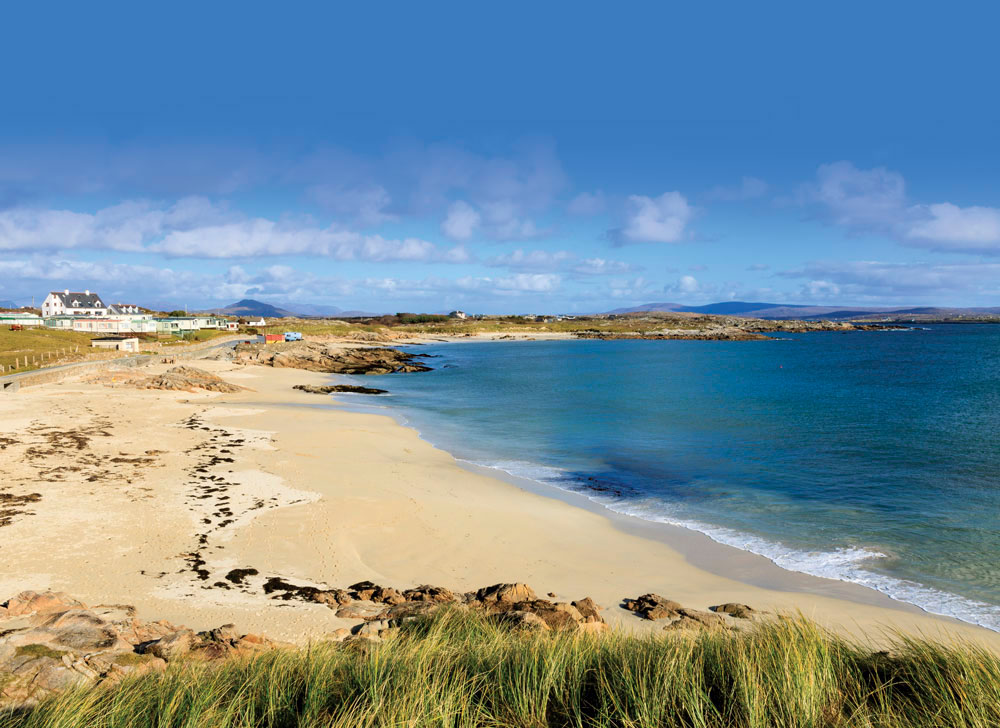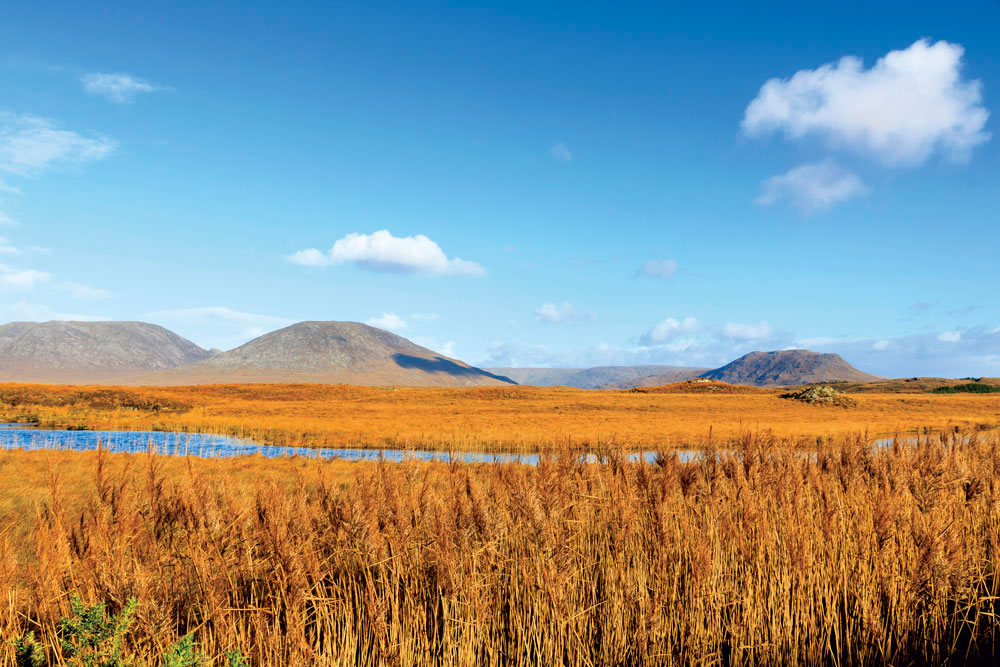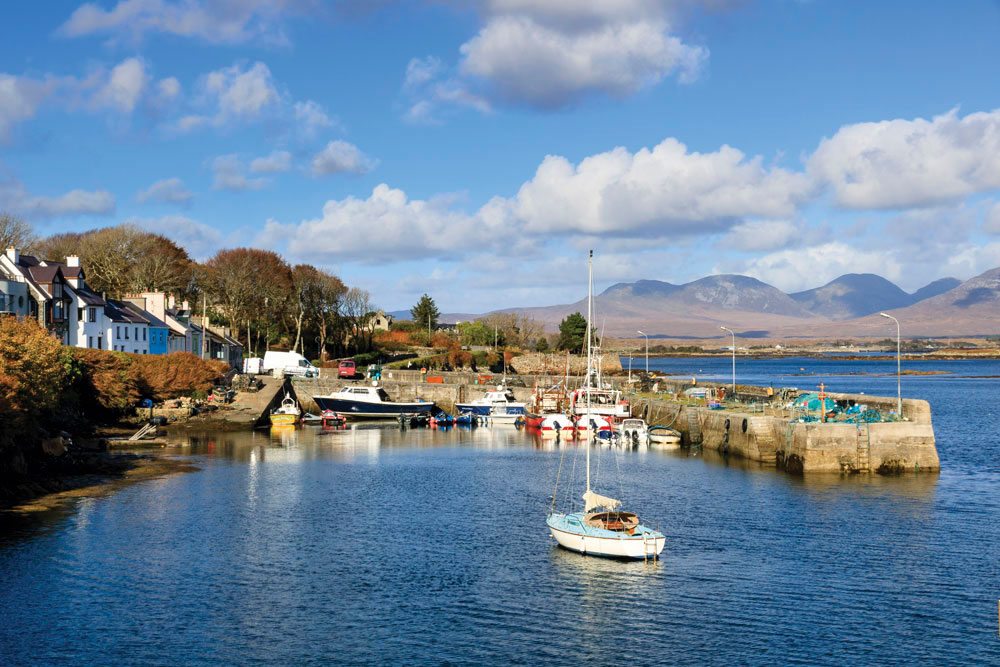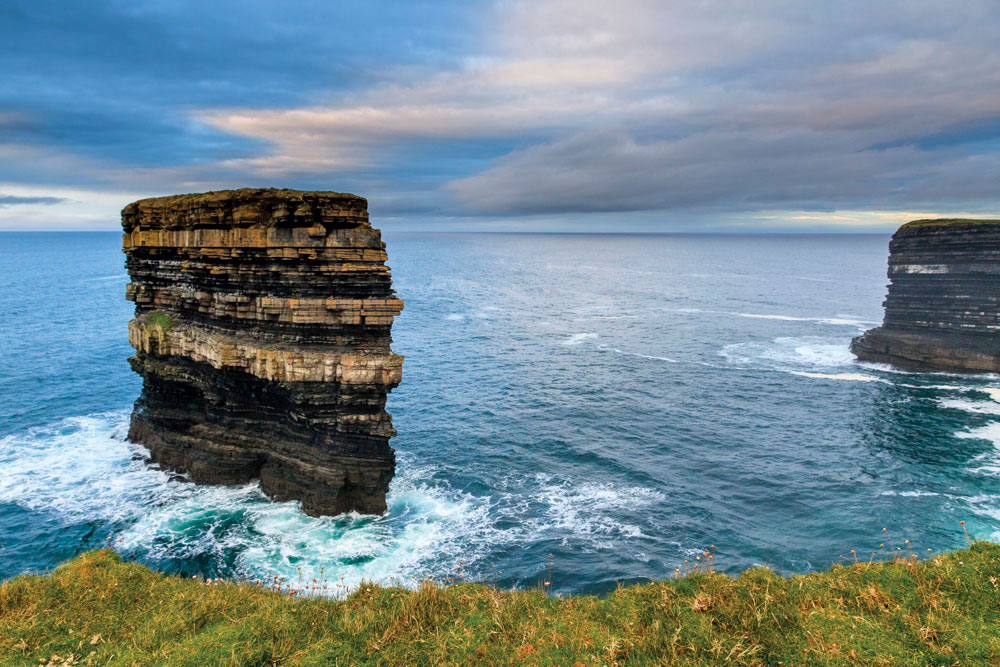Motorhome travel: The west coast of Ireland by campervan
See also: Campervan: Travel and Destination Guide
Words and Photos: Felicity Martin
Bing Crosby’s dulcet baritone plays in my head as I lie in Stella’s double bed (Stella is our WildAx Constellation campervan) with the sound of halyards slapping on masts as a background accompaniment.
We are parked overnight by the harbour wall at Galway Marina (Editor's note: overnight parking at Galway Marina no longer available), having seen a wild sunset as brilliant rays briefly streamed under the clouds. An overcast sky meant no moonrise, but the coloured lights on boats and buildings created an enchanting scene, their impact doubled by their reflections in the water.
From Galway to Sligo on the Wild Atlantic Way

From Galway we plan to spend the next week driving some of the Wild Atlantic Way northwards, circumnavigating Galway and Mayo and finishing in Sligo.
Being late October we can expect some wild Atlantic weather, but know we can stay cosy in Stella when the wind howls. Most of the campsites on the west coast are shut by the end of September. However, there are enough open for emptying and refilling the campervan when needed.
At dawn we put a few more euros in the parking machine, buying some time to explore the city of Galway. We walk up the river, passing the modern Galway City Museum and under the Spanish Arch in the old town wall.
The path leads us between the River Corrib and a mill stream, both flowing fast and full with weirs directing water in multiple directions to old mills. At the salmon weir bridge we cross to Galway Cathedral, with a dome like that of St Paul’s.
In Wood Quay, I spot an Italian café with irresistible cakes and pastries. The servers talk Italian to each other and a couple of customers greet each other in Gaelic, so it feels delightfully ‘foreign’.
We visit the tourist office, housed in a dazzlingly smart space with illuminated displays on the walls and comfy seating.
In total the Wild Atlantic Way is 2,500km (1,553 miles) long as it follows every wiggle of the coast, including many of the islands.
We’re only doing about a quarter of it, so we need to be selective – otherwise it’ll take us a month rather than the week we have available. That’s why, on the first stretch, we take a shortcut along the N59. It offers smoother and faster progress than sticking to the minor roads along the shore.
Loch Corib and Aughnanure Castle

We’re heading to Oughterard on Loch Corrib, one of an incredible number of island-studded lochs in Connemara, when I spot a brown sign and turn right on impulse. Aughnanure Castle proves a great find and is the first place where we meet Grace O’Malley, a strong woman whose story we trace on this journey.
Standing on what is virtually a rocky island, Aughnanure is a delightful little castle built by the O’Flahertys, who effectively ruled Connemara. In 1546 they were united with the Mayo O’Malleys, when Donal O’Flaherty married Grace O’Malley.
Rather than being a traditionally subservient woman, Grace cut off her hair when she was a young girl so that she could go to sea with her father. On his death she inherited his large shipping and trading business, taking command of hundreds of men and some 20 ships. True to the family motto, ‘Powerful by land and by sea’, she led raids on rival clans and merchant ships, earning her the nickname ‘Pirate Queen’.
On the west side of Oughterard we visit another place with a fascinating story – Glengowla Mines, where John eagerly gives us a tour, describing the history and geology of the place with exceptional knowledge. In the mid-1800s the tenant farmer began ploughing up rocks embedded with large silvery grey crystals, which he placed along the top of a wall.
When his landlord saw these glistening chunks he sent some away for analysis and discovered it was an unusually rich deposit of galena ore, containing 80% lead and 3% silver. John shows us enormous crystals of fluorite and calcite. They are so translucent that the light shines through them.
Kitted out with helmets we descend steps into the dim mine with John carrying a torch to point out features. He explains how the miners, who were only paid for ore they found, worked 12-hour shifts day and night.
They traced veins deep underground, hammering holes for explosives to release the ore. It was an incredibly hard and dangerous life, but when the mine closed in 1865 they mourned the comradeship of their fellow miners.
Returning to the little coast roads, we drive around two peninsulas, following Wild Atlantic Way signage.
The Twelve Pins and lunch at Roundstone

The landscape of ochre-covered bog, rocky outcrops and myriads of small lochs, is enhanced by fabulous views to the Twelve Pins, a range of grey quartzite-topped mountains. We lunch on seafood chowder at Roundstone, said to be the most beautiful town in Connemara, with brightly painted houses and an attractive harbour.
Nearby we visit a pair of beaches that back onto each other, either side of a tombolo – a narrow spit of land attaching an island to the mainland. We walk a mile along Port na Feadóige (Gorteen Bay). The vast stretch of wet sand is dazzling in the brilliant sunshine, while scattered diamonds of light bounce off the turquoise sea.
When we cross the dunes and machair to Cuan an Mhada (Dog’s Bay), the west wind blows stinging sand in our faces and we quickly retreat to the sheltered east side. As we’re travelling through the Gaeltacht, the region where Irish is the first language of most people, place names are often in Gaelic and any one place may have a variety of anglicised spellings.
Beyond Clifden we visit the Connemara National Park Centre, its buildings tucked out of sight amid the rolling contours. The interpretation is excellent: informative, but not too much to read and absorb.
Kylemore Abbey and Westport House
Our next stop is at Kylemore Abbey, lying on a lake within a mountain pass. It is a Benedictine nunnery and both the order and the fairytale mansion they inhabit have a fascinating history. Mitchell Henry, a wealthy doctor from London, created the luxurious house and wooded estate out of rough scrub and bog and gave it as a gift to his wife. After she died tragically young from dysentery, while they were on holiday in Egypt, Henry constructed a beautiful Gothic church in her memory. It’s a delightful ‘cathedral in miniature’ in the grounds.
Another place not to be missed is “the most beautiful house in Ireland” at the head of Clew Bay in Mayo. Westport House was built on the foundations of one of Grace O’Malley’s castles. Started in 1679, it was subsequently extended into a stately square house with balustraded terraces.
The ground floor rooms are laid out with lavish interiors as they would have been in the heyday of the grand house.
It is Halloween week and the basement, which includes the original castle dungeons, has a few spooky surprises.
The town of Westport, a short walk away through parkland, is the most attractive we’ve seen, with pastel-painted Georgian buildings and obelisks marking the main junctions. This would be a fine place in which to linger longer.
Continuing around the north side of Clew Bay, we stop at the ruins of Burrishoole Abbey then visit Rockfleet Castle. This austere tower house, built on tidal rocks, is currently closed. It is where Grace O’Malley saw out her old age. Ever vigilant, she slept with her boat’s mooring fed through a window and tied to her bed.
Wild goats graze by the road as we approach Ballycroy National Park Centre – a big, white angular structure standing out against the russet moorland. We’d been told in the pub the night before to come here for delicious homemade cakes. After chatting to a ranger about corncrakes and hen harriers we indulge ourselves in the café upstairs.
On the north-facing cliff coast of Mayo we visit Downpatrick Head, a place with an atmospheric presence. Rollers are powering in off the Atlantic and crashing against the stepped layers of limestone rock. Pastures end abruptly in a vertical drop of about 150 feet to the sea. Across the chasm is Dun Briste, a sea stack that was connected to the mainland until a hurricane destroyed the natural arch in 1393.

Another site, near Sligo, is Carrowmore Megalithic Cemetery. We visit about 10 of the oldest tombs, which are dolmen with large capstones, most surrounded by a ring of boulders. Excavation revealed lots of burnt bones, as well as artefacts such as beads and beaker ware.
We end our Wild Atlantic Way trip in WB Yeats country. At Drumcliffe, we visit his grave and are eagerly shown around St Columba’s Church by the custodian, who has come to lock up at dusk. A Celtic cross and a round tower, now reduced to half height, are relics of the monastery Columba founded here. We are told we’re welcome to stay overnight in the church’s car park.
Our last stop is at Glencar Lough, Yeats’ inspiration for the Lake Isle of Innisfree. We walk to the waterfall that features in his poem, The Stolen Child.
A café serves coffee and cake as we look out on the lovely autumnal scene and reflect on our all-too-brief journey. The scenery has been glorious and similar to Scotland’s Western Isles, but with more people. It is the hospitality of these people that’s most striking. They take time to talk to strangers in a naturally welcoming style.
Our journey on the Wild Atlantic Way
From home in Perthshire we took the Cairnryan to Belfast ferry and drove to the west coast of Ireland after visiting family in Northern Ireland. We spent seven nights following the Wild Atlantic Way from Galway to Sligo during October. Our journey covered 975 miles.
The costs
Fuel: (Average 32mpg) £186.85
Ferries: Cairnryan-Belfast return £215.75
Site fees: £40.60
Parking: Stephenstown Pond, Galway, Clifden £7.95
Attractions (Two adults):
Aughnanure Castle, Céide
Fields, Carrowmore Megalithic Cemetery, Glengowla
Mines, Kylemore Abbey, Westport House £83.85
Total costs: £535
This trip took place prior to the coronavirus pandemic. We are publishing it for your enjoyment and to help you plan your future trips. Read the latest camping travel advice here.
Expert Campervan advice to your door!
Campervan is the exciting monthly magazine that will give you all the inspiration you need to explore the world in your campervan. Every issue is packed with real-life campervanning experiences, inspiring travel ideas in the UK and further afield, the best campsites to stay on, campervan road tests and reviews of the latest models, and much more!
Want to know more about Campervan Magazine?








Recent Updates
Where and how to sell my motorhome: the ultimate guide
Whatever your reason for selling, there are a number of steps to take to try to get the best price for your motorhome or campervan
Gas tanks or refillable cylinders: our guide to motorhome gas
From cooking dinner to the central heating, gas is an essential feature of motorhoming – here, we explore ...
Engine management lights: all you need to know
What is the engine management light? What does it mean, and what do I have to do? ...
Motorhome air suspension: all you need to know
Motorhomes are heavy and the additional weight of equipment and height of the bodywork can increase the loads ...
Motorhome WiFi: how to get better motorhome internet
Staying connected on the move is more and more essential, so relying on campsite WiFi isn't an option – here ...
A class of their own - our guide to A-class motorhomes
Thinking of trading up to an A-class, or even going straight to the top of the motorhome tree? We guide you ...
Explore overseas on a motorhome dream tour
Enjoy exotic travel in a campervan or motorhome by hiring, swapping with someone else or exporting your ...
Motorhome water systems: everything you need to know
On-board water is an important part of every motorhome – here’s everything you need to know ...
Campervanning in Europe: what you need to know
Whether you're planning a leisurely drive through the French countryside, navigating bustling city streets in ...
Campervan security: all you need to know
With thefts on the increase, it’s important to know how to keep your campervan secure and prevent campervan ...
Other Articles
Campervan furniture: everything you need to know
Our campervan experts guide you through all the essentials for your campervan, including tables, chairs, inflatable seating, windbreaks and ...
Campervan finance: how to fund your purchase
Here we look at the different types of campervan finance available, to help you decide what’s the best option ...
Britain’s best used motorhomes
Want a great motorhome without paying the premium for a new one? Here's a guide to the best you can get in ...
Which motorhome? Choosing the perfect motorhome for you
Choosing a motorhome or campervan is one of the biggest buying decisions you’ll ever make, so it's important ...
Campervan washroom essentials: stay fresh on the road
Our guide will take you through the campervan washroom essentials you'll need so you're well-prepared for ...
Dogs in campervans: all you need to know
Follow our advice and your dog will enjoy campervanning as much as you do ...
Electric campervans: all you need to know
Our guide will take you through everything you need to know about electric campervans and what the future ...
Motorhome electrics: a complete guide to your motorhome electrical set-up
Motorhome electrics can dramatically enhance the convenience and comfort of your vehicle – but they can be ...
Lighting for campervans: all you need to know
We guide you through all the lighting options available for you and your campervan, including interior ...
Electric bikes for motorhomes: our ultimate guide
Read our comprehensive guide to electric bikes for motorhome owners, helping you add electric power to your ...